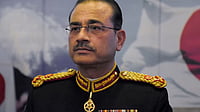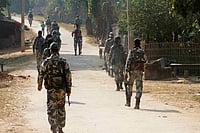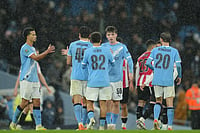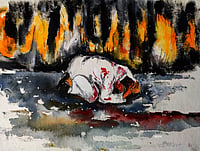In an increasingly politically correct world, men are finally changing. And the first whiffs are felt in their shirts and trousers. As manstyle evolves and men increasingly shop around like women, the branded apparel market is sizzling and undergoing nothing short of a revolution, with marketers continuously pausing to lick their burnt fingers.
According to consultancy firm KSA Technopak, the branded readymade menswear market is worth over Rs 5,000 crore a year. Shirts account for 35 per cent of this and trousers, 15 per cent. And growing at an annual average of seven per cent and 13 per cent respectively, with the consumer driving changes. The ncaer predicts that over the next three years, 25 million more households will join the 55 million now earning over Rs 90,000 a year. Most of these will queue up for luxury items like a stitched shirt or pants. KSA estimates a 5-15 per cent increase in the market size of apparels every year the next 10 years.
The Indian man, says Nabankur Gupta of Raymond Apparel Ltd (RAL), is thinking like a woman. Today he is reshuffling and expanding his wardrobe, looking beyond the light blue-grey-beige spectrum to peach, pink and mauve, bright checks, and indigos. Old-fashioned yardage has given way to lycra and experiments with different fits. Vikram Rao of Madura Garments sees men gradually buying into lifestyles. All this may have led to fashion casualties like broad-toed shoes being worn with narrow-bottomed trousers, but overall it spells plumper bottomlines for apparel makers. But these bottomlines are also getting tougher to achieve. Quality and brand value now occupy centrestage. Apparel today competes with other accessories like mobile phones and travel packages. So suppliers who don't buck up will buckle under.
That may lead to a further consolidation. The A.V. Birla Group's Indian Rayon acquired Madura Garments in 1999, getting hold of leading brands Louis Philippe, Van Heusen and Allen Solly. Color Plus, the fast-rising star in the business, challenged Allen Solly in the category it created and became a Rs 92-crore brand. Now the Rs 250-crore Singhania group's Raymond Apparel Ltd (RAL) has bought it. After burning its fingers with Vivaldi, Nusli Wadia's Bombay Dyeing has now invested in Proline India and plans to relaunch Vivaldi. The other big player, Sanjay Lalbhai's Arvind Brands Ltd, covers the spectrum through its own brands and tie-ups. It owns Arrow at the high-end and Excalibur and Bay Islands in the mid-price slot. Ruggers is its premium casuals brand. A similar grading is followed in denim—Wrangler and Lee at the top, followed by Flying Machine and Newport.
Why consolidation instead of proliferation in a market where growth's almost assured? Kabir Lumba, coo, Proline, explains that steady growth has come with increased pressure on operating margins. Hence consolidation, as companies "feel the need to build scale for obvious advantages". Another reason is that unlike most other product categories from PCs to fast food, where costs have come down by 45 to 15 per cent since 1991, the apparel and textile industry has done insignificant value engineering. Still, says Arvind Singhal, chairman, KSA Technopak, there is a potential of saving up to 20 per cent on costs through better products and systems. But this may be best possible in large corporations.
As more families scale up, growth will come in the middle categories. Here, the big companies have a different animal to face. Darshan Mehta, president, Arvind Brands Ltd, talks of the "gorilla" brands—the strong local and regional players who provide stiff competition to the mid-priced brands. And they are growing in strength. They enjoy two distinct advantages. One, entering this industry requires very little in terms of capital, technology and people.Two, they often get huge benefits on taxes and duties like excise which leads to an unlevel playing field, feels Mehta. This has led brands like Peter England and Excalibur into the discounting trap, damaging the brand values. "Your topline has little to do with perception of premium or profits," says he.
The second challenge is to become all things to all people. Rao points out that all premium brands are striving to become lifestyle brands, while the popular ones are evolving from single product to wardrobe brands—Proline has a strong presence in the sports and casualwear segments, whereas Vivaldi can help Bombay Dyeing target mid-price formal wear category. Madura's Louis Philippe and Van Heusen comprise formals, while Allen Solly pioneered the concept of Friday Dressing. In the past three years, Madura has introduced Peter England and San Frisco at the low-end, and formal suits, T-shirts, jeans, women's wear and accessories across their brands to leverage them into lifestyle brands. MG has also set up concept stores under two brand names, Trouser Town and Planet Fashion. For RAL, Park Avenue and Parx were the middle-range in formals and casuals, while Manzoni covered the high-end formal range. To fill the top-end casuals niche, it bought Color Plus. Now it is leaning towards designer garments and women's wear under its label, Be.
Surely, the entropy in the market is growing considerably. New entrants can make it critical for older brands to consolidate their positioning. When ColorPlus arrived and flourished, it challenged Allen Solly in the category of topline smart casuals that the latter had created. Increasingly, brands will have to fight hard to find their specific niches or get displaced or unwillingly repositioned.
More stylish and better cuts, a range of fabrics and higher-quality stitching is already available. If your brands do not offer distinct usps, they could be the casualties. Says a trade analyst: "Brands offer very little product differentiation sometimes. Two top-end brands of a leading company have been mistaken for one another." Similarly, Allen Solly took a beating as Color Plus, with its super cotton fabric and natty styling, took the lead. Also, Peter England and Excalibur have been recognised as discount brands to the point that buyers stopped shopping for them at their regular prices.
But for all the ease of entry, the apparel business isn't simple if you want to make it big. Gupta says that it's a cross between the textile, FMCG and the durables business. While the technical understanding of fabric is vital, distribution is akin to the durables business. But the branding and the supply chain management is like the FMCG products in areas like shelf-life and turnaround time (of designs). After Mehta took over, he decided that for the 2002-03 financial year, no brand of his would be on sale more than once a year in a city. "I de-grew Excalibur topline by 22 per cent but my profitability jumped 2. 5 times." Now this Rs 45-crore brand is poised to grow by 18 per cent this year.
But then, last year has been a tad difficult. RAL is just about doing its previous revenues. The Rs 500-crore Madura has reported a loss in the first three quarters, but plans to invest and expand haven't faltered. It hopes to grow by 20 per cent by 2006 and triple the retail outlets in two years while growing new categories. Stock redundancy was another problem that came from fast-changing fashion trends. Now players like MG and RAL are improving their distribution systems. The aim is to increase flexibility and customisation whereby orders can be supplied at the desired size, colour and design at a better strike rate. This reduces accumulation of slow moving stocks, increases stock turns at both the distributor's and the retailer's ends, which in turn improves the profitability of the channel partners.
So get ready for some sharp snipping of scissors as the battle for men's apparel gets really sizzling.
Dandified Delights
The Indian man is thinking like a woman. Apparel companies never had it better.

Dandified Delights
Dandified Delights
Published At:
MOST POPULAR
WATCH
MORE FROM THE AUTHOR
PHOTOS
×





















